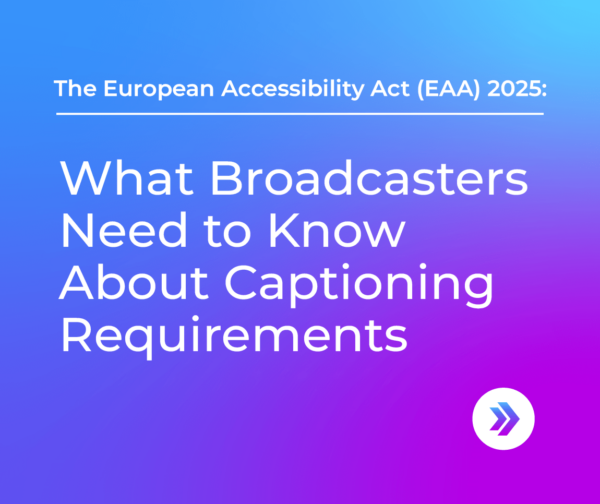
The European Accessibility Act (EAA) 2025
The European Accessibility Act (EAA) 2025: What Broadcasters Need to Know About Captioning and Subtitling Requirements
As the European Accessibility Act (EAA) 2025 approaches, there is some concern and confusion within the broadcasting industry about the specific requirements, particularly around captioning and subtitling. This article aims to summarize our current understanding of the EAA’s intent, where captioning is referenced, what it means for broadcasters, and what steps are necessary to ensure compliance. We are happy to inform our readers that we have also scheduled an interview with the European Union in September to gain further insights, and we will provide updates following that session. Please note that this article represents our interpretation, and we strongly advise reaching out to your legal experts for clarification and confirmation.
Understanding the Intent of the EAA
The EAA is a landmark legislative framework designed by the European Union to improve accessibility for individuals with disabilities across a broad range of goods and services. Taking effect on June 28, 2025, the EAA mandates that businesses operating within the EU, as well as those outside the EU but providing services to EU residents, must ensure that their products and services are accessible. The Act is particularly focused on digital and online services, including audiovisual media, to foster a more inclusive society.
Key Focus Areas of the EAA 2025
The EAA 2025 covers several crucial areas to ensure accessibility:
- Digital Accessibility: Websites and mobile applications must align with the WCAG, ensuring that digital content is perceivable, operable, and understandable for all users, including those with disabilities.
- Audiovisual Media: Broadcasters and streaming services are required to incorporate features like closed captions and audio descriptions to make content accessible to individuals with hearing or visual impairments.
- Banking Accessibility: Financial institutions must enhance the accessibility of both digital and physical platforms, ensuring services like ATMs are equipped with audio assistance for visually impaired users.
- Assistive Technologies: The EAA emphasizes the need for digital products and services to be compatible with assistive technologies such as screen readers and speech recognition software.
- Electronic Communication: Communication methods, including email, messaging services, and mobile phones, must be accessible and user-friendly for individuals with disabilities.
Captioning and Subtitling: Where Is It Referenced?
The EAA directly addresses the need for enhanced accessibility in audiovisual media, which includes the mandatory provision of captions and subtitles. Here’s where these requirements are found:
Audiovisual Media Accessibility: The EAA stipulates that any company producing or distributing television content, or offering streaming services, must integrate accessibility features such as closed captions and audio descriptions. This ensures that individuals with hearing or visual impairments can fully engage with audiovisual content.
Digital Accessibility Compliance: The EAA also mandates compliance with the Web Content Accessibility Guidelines (WCAG) 2.1, which include specific provisions for captioning. These guidelines require businesses to provide text alternatives for any non-text content, such as audio, which directly translates to the need for captions and subtitles in digital media.
Implications for Broadcasters
The EAA’s captioning requirements mean that broadcasters will need to make significant adjustments to their workflows and technology to ensure compliance. Here are the key implications:
- Technology Upgrades: Broadcasters will need to invest in or upgrade captioning and subtitling software to ensure that all content meets the required accessibility standards.
- Staff Training: Implementing these changes will likely require training for staff to operate new technology and ensure that content is consistently accessible.
- Regular Compliance Checks: Broadcasters must regularly assess their content for compliance with the EAA’s standards. This includes ongoing audits and updates to ensure that accessibility features, like captions and subtitles, are up to date and effective.
Steps to Ensure Compliance
According to the Directive, to meet the EAA’s requirements, broadcasters should take the following actions:
- Conduct Accessibility Audits: Start with a comprehensive audit of your current services to identify any gaps in accessibility, particularly in captioning and subtitling.
- Develop a Compliance Roadmap: Create a strategic plan that outlines the necessary steps, timelines, and resources needed to meet EAA standards by June 2025.
- Engage with Experts: Consider working with accessibility experts to guide your efforts and ensure that all necessary measures are taken.
- Stay Updated on Legislative Changes: Given the potential for further clarifications and updates, it’s crucial to monitor any changes to the EAA and adjust your compliance efforts accordingly.
Repercussions for Non-Compliance
It has been suggested in the literature that failure to comply with the EAA can have serious consequences:
- Financial Penalties: Businesses found to be non-compliant could face fines of up to €1,000,000, depending on the severity and context of the infraction.
- Market Removal: In cases of continued non-compliance, the EAA allows for the removal of non-compliant services or products from the European market, which could severely impact broadcasters’ operations and revenues.
Conclusion: Awaiting Further Clarification
While the EAA’s requirements are clear in some respects, there is still uncertainty in the marketplace regarding the specific obligations around captioning and subtitling. We acknowledge these uncertainties and want to assure you that we are actively seeking further clarification. We have scheduled an interview with representatives from the European Union in September, and we will provide detailed updates following that session.
For now, we recommend that broadcasters begin preparing by conducting audits, upgrading their technology, and staying informed about any legislative changes. The EAA 2025 deadline is approaching FAST and the extensive requirements mean that early action is essential to ensure compliance and avoid the penalties associated with non-compliance. To discuss how AI-Media can support your captioning and subtitling needs for both live and recorded content, contact us today.
Please note that this article represents our interpretation, and we strongly advise reaching out to your legal experts for clarification and confirmation.